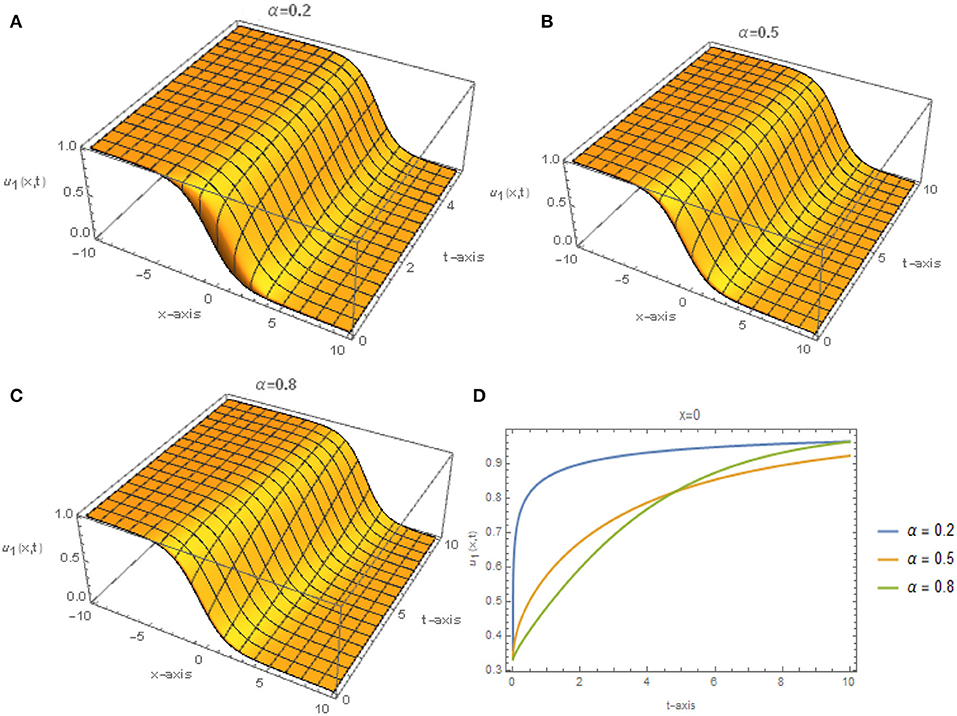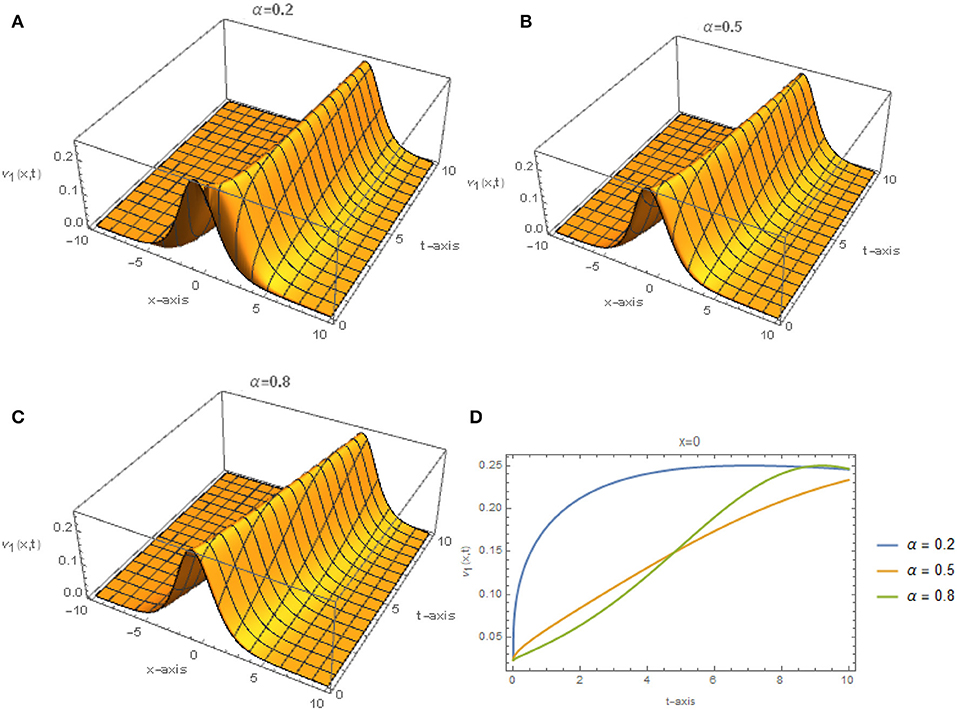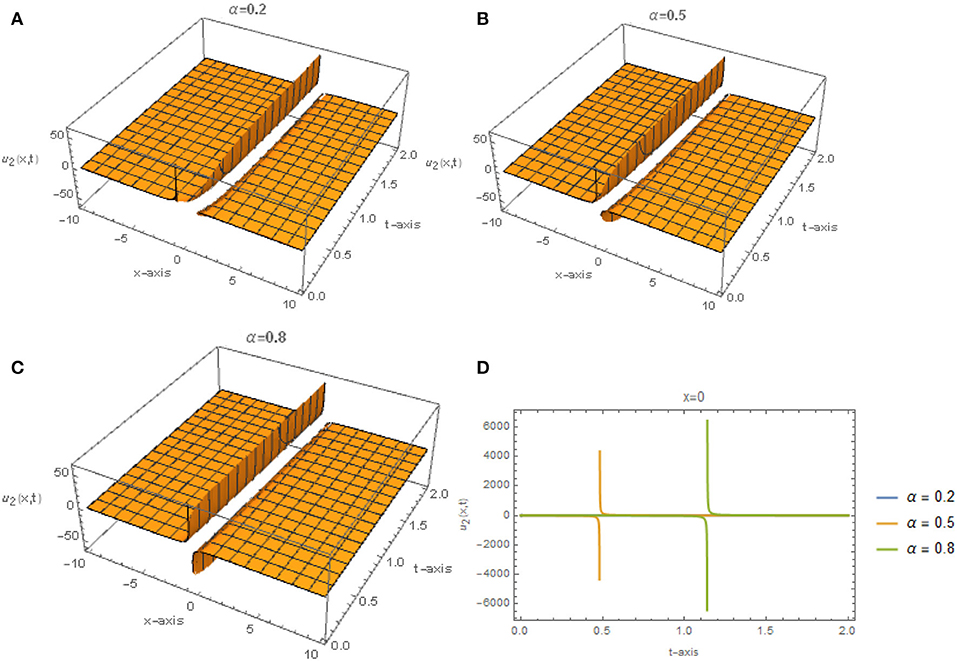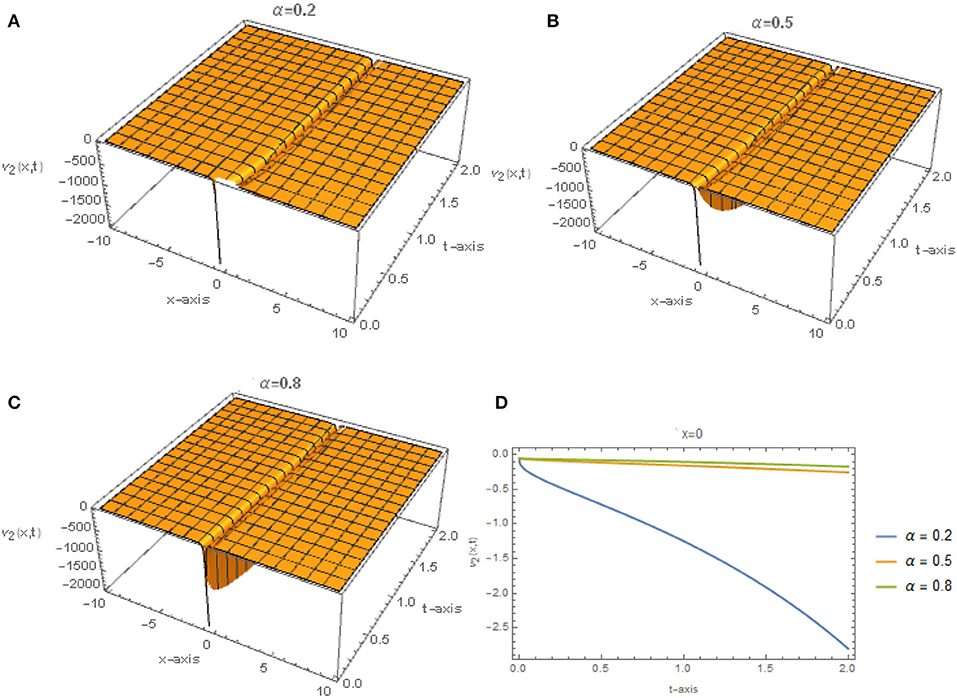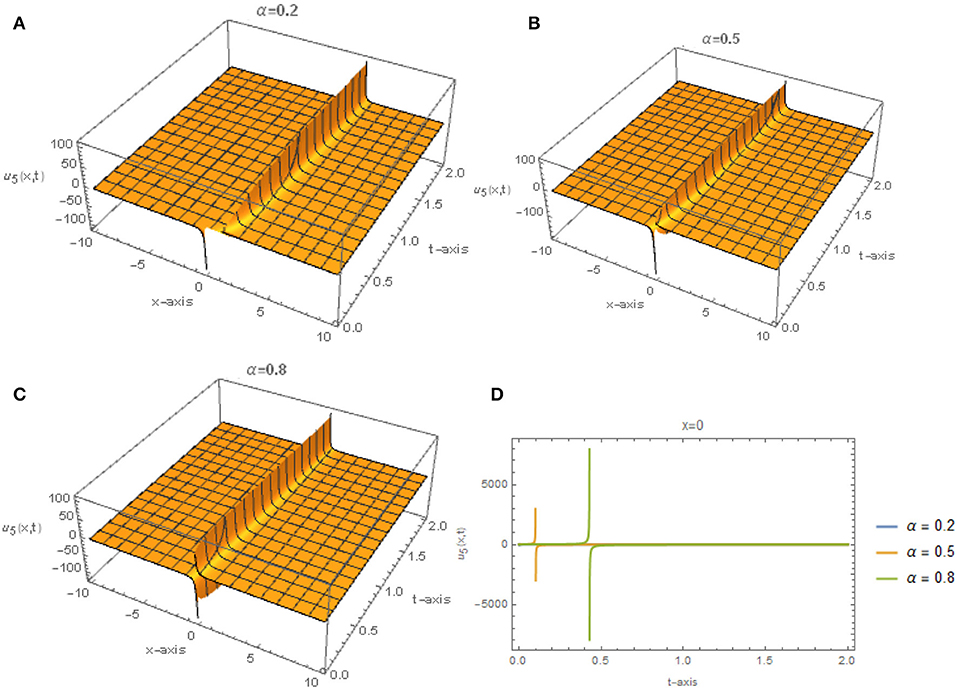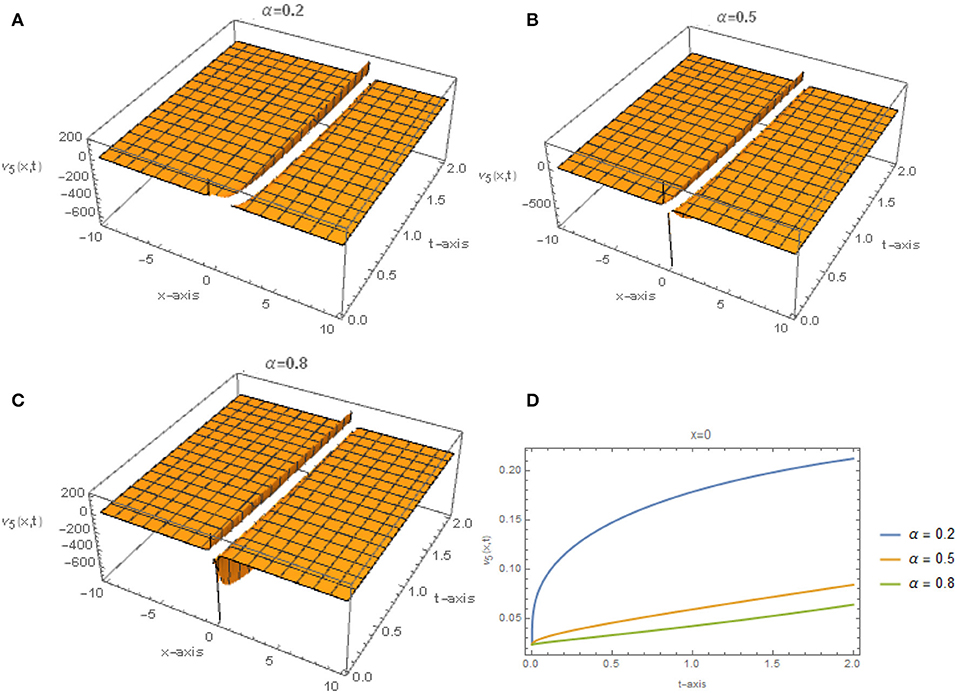- 1Graduate School of Systems and Information Engineering, University of Tsukuba, Tsukuba, Japan
- 2Department of Mathematics, Bangabandhu Sheikh Mujibur Rahman Science and Technology University, Gopalganj, Bangladesh
- 3Department of Mathematics, Art-Science Faculty, Kastamonu University, Kastamonu, Turkey
- 4Department of Mathematics, University of Rajshahi, Rajshahi, Bangladesh
- 5Department of Mathematics, Faculty of Science, Cairo University, Giza, Egypt
- 6Department of Mathematics, Faculty of Applied Science, Umm Alqura University, Makkah, Saudi Arabia
- 7Department of Mathematics, Faculty of Arts and Sciences, Çankaya University, Ankara, Turkey
- 8Institute of Space Sciences, Magurele-Bucharest, Romania
- 9Department of Medical Research, China Medical University Hospital, China Medical University, Taichung, Taiwan
For different nonlinear time-conformable derivative models, a versatile built-in gadget, namely the generalized exp(−φ(ξ))-expansion (GEE) method, is devoted to retrieving different categories of new explicit solutions. These models include the time-fractional approximate long-wave equations, the time-fractional variant-Boussinesq equations, and the time-fractional Wu-Zhang system of equations. The GEE technique is investigated with the help of fractional complex transform and conformable derivative. As a result, we found four types of exact solutions involving hyperbolic function, periodic function, rational functional, and exponential function solutions. The physical significance of the explored solutions depends on the choice of arbitrary parameter values. Finally, we conclude that the GEE method is more effective in establishing the explicit new exact solutions than the exp(−φ(ξ))-expansion method.
Introduction
Analytical solutions of the non-linear partial differential equation (NPDEs) are significantly more important for describing the physical meaning for any real-world problems. Due to the rapid expansion of computer technologies and computer-based symbolic tools, researchers have concentrated increasingly on the analytical and numerical solutions for the NPDEs, including integer and fractional orders. During recent decades, several analytical and semi-analytical methods, such as the improved fractional sub-equation [1], the exp function method [2, 3], the G′/G-expansion [4–7], the tan(Φ(ξ)/2)-expansion [8], the modified Kudryashov [9, 10], the new extended direct algebraic [11], the extended exp(−φ(ξ))-expansion [12], the RB sub-ODE [13], the sine-Gordon expansion [14–16], the unified [17, 18], and the generalized unified [19, 20] methods, have been investigated and also employed for acquiring the new exact solutions of the well-known NPDEs that arise in applied sciences. Presenting new exact solution of PDEs provides a better understanding of the phenomena, which are governed by three special form of time-fractional WKB equations.
The time-fractional Whitham-Broer-Kaup (WBK) equation has the following structure [21]
Eq. (1) describes the dispersive long wave in shallow water [22] where u = u(x, t) is the velocity field in the horizontal direction, v = v(x, t) is he height which deviates from the liquid balance position, and β and γ are real parameters [23]. is conformable derivative of order α. In the past, many researchers studied the WBK equation via different analytical approaches according to their field, particularly within mathematical physics and ocean engineering. For instance, Guo et al. [24] employed the improved sub-equation method to extract analytical solutions for space- and time-fractional WBK equations. El-Borai et al. [25] applied the exp-function method under the sense of the modified Riemann-Liouville derivative for solving the time-fractional coupled WBK equations.
If we choose the free parameters as and γ = 0, Eq. (1) is converted to the time-fractional approximate long-wave equations [21]:
In past, Eq. (2) have been solved by the fractional sub-equation method [26], the G′/G-expansion method [24], and the generalized Kudryashov method [27] for establishing different wave solutions.
Again, we substitute β = 0 and γ = 1 in Eq. (1), and Eq. (1) is converted to the following time-fractional variant Boussinesq equations [21]:
Equation (3) was solved by Yan [26] by using fractional sub-equation method. The improved fractional sub-equation method [24] was applied for producing the new generalized exact solutions of the space–time-fractional variant Boussinesq equations.
Finally, if we choose the free parameter values β = 0 and in Eq. (1), Eq. (1) is the converted to the following time-fractional Wu-Zhang system of equations [27]:
Eslami et al. [27] solved the time-fractional Wu-Zhang system of equations using the first integral method by considering conformable fractional sense.
If we consider α = 1in Eq. (1), then it is converted to the classical coupled WBK equation, which was first introduced by Whitham [28], Broer [29], and Kaup [30]. When α = 1, β ≠ 0, and γ = 1, Eq. (1) is the classical long-wave equation that describes the shallow water wave with diffusion. When α = 1, β = 0, and γ = 1, Eq. (1) reduces the classical variant Boussinesq equations [31], and when α = 1, β = 0 and γ = 1/3, Eq. (1) reduces the classical Wu-Zhang system of equations [32]. Sometimes, the classical Wu-Zhang system of equations are introduced by the (1+1) dimensional dispersive long-wave equations [33–35].
For the simplicity of the solutions, we did not consider solving the time-fractional WKB equations by the generalized exp(−φ(ξ))-expansion method. The main aim of this work is to construct the new exact traveling wave solutions of the three-special form of time-fractional WKB equations, such as the time-fractional approximate long-wave equations, the time-fractional variant Boussinesq equations, and the time-fractional Wu-Zhang system of equations using the generalized exp(−φ(ξ))- expansion method with a conformable derivative sense. The generalized exp(−φ(ξ))-expansion method is an effectual and easily applicable technique that is used to investigate the new exact solution for different integer- and fractional-order PDEs. Very recently, Lu et al. [36] used the generalized exp(−φ(ξ))- expansion method and construct the exact solutions of space–time-fractional generalized fifth-order KdV equation with Jumarie's modified Riemann-Liouville derivatives.
The rest of the paper is arranged as follows. In section Conformable derivative and the generalized exp(−φ(ξ))-expansion method, some basic definitions of conformable derivative and the main steps of the generalized exp(−φ(ξ))-expansion method are given. In section Application of the generalized exp(−φ(ξ))-expansion method, we look for the exact solutions of Eq. (2) to Eq. (4) via the generalized exp(−φ(ξ))-expansion method. Finally, a brief conclusion is provided in the last section.
The Conformable Derivative and the Generalized exp(−φ(ξ))-Expansion Method
Khalil et al. [37] started to give us the first definition of the conformable derivative (CD) with a limit operator as follows.
Definition 1. If f : (0, ∞) → R, then the CFD of f order α is defined as
The CD satisfies some workable features that are demonstrated in the following theorems [37–41].
Theorem 1. Let α ∈ (0, 1] and f = f(t), g = g(t) be α-conformable differentiable at a point t > 0, then
Furthermore, if f is differentiable, then .
Theorem 2. Let f : (0, ∝) → R be a function such that f is differentiable and α-conformable differentiable. Also, let g be a differentiable function defined in the range of f. Then
where prime denotes the classical derivatives with respect to t.
Now, we impose the generalized exp(−φ(ξ))-expansion method for solving some fractional differential equations. In this respect, we described the essential steps of the generalized exp(−φ(ξ))- expansion method [36] as follows.
Step-1: Suppose that a general form of the non-linear FDEs, say in two independent variables x and t, is given by
where and are conformable derivatives of u and v, respectively, u = u(x, t) and v = v(x, t) are an unknown functions, and P1 and P2 are a polynomial in their arguments.
Step-2: To construct the exact solution of Eq. (5), we introduce the variable transformation, combine the real variables x and t by a compound variable ξ
where, c is a constant which is determined later. The traveling wave transformation of Eq. (6) converts Eq. (5) into an ordinary differential equation (ODE) for u = U(ξ) and v = V(ξ):
where Q1and Q2 are a polynomial of U, V, and its derivatives with respect to ξ.
Step 3: Suppose that the traveling wave solution of system Eq. (7) can be presented as follows
where the arbitrary constants ai(i = 1, 2…, m) and bi(i = 1, 2…, n) are determined latter, but am ≠ 0 and bn ≠ 0 and also m and n are a positive integer, which can be determined by using homogeneous balance principle on Eq. (7), and φ = φ(ξ) satisfies the following new ansatz equation
where p, q, and r are constant. The general solutions of the equation are the following.
Case-I: When p = 1 and Δ = r2 − 4q, one obtains
and
Case-II: When r = 0, one obtains
Case-III: When q = 0 and r = 0, one obtains
For all cases, E is the integrating constant.
Step 4: Inserting Eq. (9) in Eq. (8) and compiling the terms in the resulting equation yields a set of algebraic non-linear equations. Finally, by solving this set we reach the exact solutions of the non-linear fractional PDEs.
Application of the Generalized exp(−φ(ξ))-Expansion Method
In this part, we will execute the generalized exp(−φ(ξ))- expansion method to solve three well-known non-linear fractional partial differential equations in shallow water, namely, the time-fractional approximate long wave (ALW) equations, the time-fractional variant-Boussinesq equations, and the time-fractional Wu-Zhang system of equations. All the above mentioned equations are the special-form WBK equations that describe the physical phenomena arising in fluid mechanics.
The Time-Fractional ALW Equations
Let us consider the time-fractional ALW equations
Now, applying under the traveling wave transformation of Eq. (6), Eq. (19) reduces to a non-linear ODE as
This integrates with respect to ξ of Eq. (20) and considers that the integration constant is zero. Eq. (20) then yields
The balancing rule in Eq. (21) yields m = 1 and n = 2, assuming the general solution Eq. (21) in the presence Eq. (8) is given by
where a1 ≠ 0 and b2 ≠ 0.
Plugging Eq. (22) into Eq. (21), we obtain a set of an algebraic non-linear equations that solve to
Set-1:
.
By putting the values of Set-1 into Eq. (22) along with the Eq. (10) to Eq. (18), we obtain the following traveling wave solutions for the time-fractional ALW equations.
For p = 1:
and
where, and = r2 − 4q > 0.
For r = 0:
and
where, .
For q = 0 and r = 0:
Set-2:
.
Consequently, by substituting the values of Set-2 into Eq. (22) along with the Eq. (10) to Eq. (18), we produce the following traveling wave solutions for the time-fractional ALW equations.
For p = 1:
and
where, and = r2 − 4q > 0.
For r = 0:
and
where, .
For q = 0 and r = 0:
Figures 1, 2 represent the solutions given by Eq. (23) for different values of α when r = 3, q = 2, and E = 0.
The Time-Fractional Variant-Boussinesq Equations
Let us consider the time-fractional variant-Boussinesq equations
Now, applying under the traveling wave transformation of Eq. (6), Eq. (45) reduces to a non-linear ODE as
This integrates with respect to ξ of Eq. (46) and considers the integration constant to be zero. Eq. (46) then yields
From the balancing condition in Eq. (47), we have m = 1 and n = 2. Now, the formal solution of (47) in the existence of (8) will be
where a1 ≠ 0 and b2 ≠ 0.
By inserting Eq. (48) into Eq. (47) along with Eq. (9) and using the same techniques investigated in the previous section we get
Set-1:
.
Therefore, by substituting the values of Set-1 into Eq. (48), along with the Eq. (10) to Eq. (18), we generate the following traveling wave solutions for the time-fractional variant-Boussinesq equations.
For p = 1:
and
where and = r2 − 4q > 0.
For r = 0:
where, .
For q = 0 and r = 0:
Set-2:
.
Consequently, by substituting the values of Set-2 into Eq. (48) along with the Eq. (10) to Eq. (18), we generate the following traveling wave solutions for the time-fractional variant-Boussinesq equations:
For p = 1:
where, and = r2 − 4q > 0.
For r = 0:
and
where, .
For q = 0 and r = 0:
Figures 3, 4 represent the solutions given by Eq. (50) for different values of α when r = 3, q = 2 and E = 0.
The Time-Fractional Wu-Zhang System of Equations
Let us consider the time-fractional Wu-Zhang system of equations
Now, applying under the traveling wave transformation of Eq. (6), Eq. (71) reduces to a non-linear ODE as
Integrating with respect to ξ of Eq. (71) and considering the integration constant is zero. Then Eq. (72) yields
Following the steps given in the last two sections we reach to m = 1 and n = 2. Consequently, the general solution will take the form
where a1 ≠ 0 and b2 ≠ 0.
Put Eq. (74) into Eq. (73) along with Eq. (9), and we get a new system of algebraic equations that solve to
Set-1:
.
Therefore, by substituting the values of Set-1 into Eq. (74) along with the Eq. (10) to Eq. (18), we generate the following traveling wave solutions for the time-fractional Wu-Zhang system of equations.
For p = 1:
and
where, and Δ = r2 − 4q > 0.
For r = 0:
and
where, .
For q = 0 and r = 0:
Set-2:
.
Consequently, by substituting the values of Set-2 into Eq. (74) along with the Eq. (10) to Eq. (18), we generate the following traveling wave solutions for the time-fractional Wu-Zhang system of equations.
For p = 1:
and
where, and Δ = r2 − 4q > 0.
For r = 0:
and
where, .
For q = 0 and r = 0:
Figures 5, 6 represent the solutions given by Eq. (79) for different values of α when r = 3, q = 2 and E = 0.
Conclusion
This research successfully applied the generalized exp(−φ(ξ))-expansion method combined with the complex fractional transformation and conformable derivative to exactly solve a special class of time-fractional WBK equations in shallow water, such as the time-fractional ALW equations, the time-fractional variant-Boussinesq equations, and the time fractional Wu-Zhang system of equations. Afterwards, a sequence of new analytical wave solutions for these models were established. Finally, some 3D and 2D plots were added for some of the gained solutions for every model to illustrate the effect of the parameter α on the behaviors of these solutions. In conclusion, we found that the method mentioned here—with the aid of symbolic computations—is aspiring and efficient, and it is a superior mathematical construction with which to deal with the NPDEs.
Data Availability Statement
The original contributions presented in the study are included in the article/supplementary materials, further inquiries can be directed to the corresponding author/s.
Author Contributions
All authors listed have made a substantial, direct and intellectual contribution to the work, and approved it for publication.
Conflict of Interest
The authors declare that the research was conducted in the absence of any commercial or financial relationships that could be construed as a potential conflict of interest.
The reviewer MB declared a past co-authorship with one of the authors DB to the handling editor.
References
1. Guo S, Mei LQ, Li Y, Sun YF. The improved fractional sub-equation method and its applications to the space–time-fractional differential equations in fluid mechanics. Phys Lett A. (2012) 376:407–11. doi: 10.1016/j.physleta.2011.10.056
2. El-Borai MM, El-Sayed WG, Al-Masroub RM. Exact solution for time-fractional coupled Whitham-Broer-Kaup equations via exp-function method. Int Res J Eng Tech. (2015) 2:307–15. doi: 10.1016/j.chaos.2004.09.017
3. Ghanbari B, Osman MS, Baleanu D. Generalized exponential rational function method for extended Zakharov–Kuzetsov equation with conformable derivative. Modern Phys Lett A. (2019) 34:1950155. doi: 10.1142/S0217732319501554
4. Guner O, Atik H, Kayyrzhanovich AA. New exact solution for space–time-fractional differential equations via G′/G-expansion method. Optik. (2017) 130:696–701. doi: 10.1016/j.ijleo.2016.10.116
5. Liu JG, Osman MS, Zhu WH, Zhou L, Ai GP. Different complex wave structures described by the hirota equation with variable coefficients in inhomogeneous optical fibers. Appl Phys B. (2019) 125:175. doi: 10.1007/s00340-019-7287-8
6. Ding Y, Osman MS, Wazwaz AM. Abundant complex wave solutions for the nonautonomous Fokas–Lenells equation in presence of perturbation terms. Optik. (2019) 181:503–13. doi: 10.1016/j.ijleo.2018.12.064
7. Liu JG, Osman MS, Wazwaz AM. A variety of nonautonomous complex wave solutions for the (2+ 1)-dimensional nonlinear Schrödinger equation with variable coefficients in nonlinear optical fibers. Optik. (2019) 180:917–23. doi: 10.1016/j.ijleo.2018.12.002
8. Manafian J, Lakestani M. Abundant soliton solutions for the Kundu–Eckhaus equation via tan(Φ(ξ)/2)-expansion method. Optik. (2016) 127:5543–51. doi: 10.1016/j.ijleo.2016.03.041
9. Ray SS. New analytical exact solutions of time-fractional KdV–KZK equation by Kudryashov methods. Chinese Phys B. (2016) 25:040204. doi: 10.1088/1674-1056/25/4/040204
10. Hosseini K, Mayeli P, Kumar D. New exact solutions of the coupled sine-Gordon equation in nonlinear optics using the modified Kudryashov method. J Modern Optics. (2018) 65:361–4. doi: 10.1080/09500340.2017.1380857
11. Rezazadeh H, Mirhosseini-Alizamini SM, Eslami M, Rezazadeh M, Mirzazadeh Abbagari MS. New optical solitons of conformable fractional Schrödinger-Hirota equation. Optik. (2018) 172:545–53. doi: 10.1016/j.ijleo.2018.06.111
12. Kumar D, Kaplan M. New analytical solutions of (2+1)-dimensional conformable time-fractional Zoomeron equation via two distinct techniques. Chinese J Phys. (2018) 56:2173–85. doi: 10.1016/j.cjph.2018.09.013
13. Inc M, Yusuf A, Aliyu AI, Baleanu D. Soliton structures to some time-fractional nonlinear differential equations with conformable derivative. Opt Quant Elect. (2018) 50:20. doi: 10.1007/s11082-018-1459-3
14. Kumar D, Hosseini K, Samadani F. The sine-Gordon expansion method to look for the traveling wave solutions of the Tzitzeica type equations in nonlinear optics. Optik. (2017) 149:439–46. doi: 10.1016/j.ijleo.2017.09.066
15. Ali KK, Wazwaz AM, Osman MS. Optical soliton solutions to the generalized nonautonomous nonlinear Schrödinger equations in optical fibers via the sine-Gordon expansion method. Optik. (2019) 208:164132. doi: 10.1016/j.ijleo.2019.164132
16. Ali KK, Osman MS, Abdel-Aty M. New optical solitary wave solutions of Fokas-Lenells equation in optical fiber via Sine-Gordon expansion method. Alexand Eng J. (2020). doi: 10.1016/j.aej.2020.01.037
17. Osman MS, Lu D, Khater MM. A study of optical wave propagation in the nonautonomous Schrödinger-Hirota equation with power-law nonlinearity. Res Phys. (2019) 13:102157. doi: 10.1016/j.rinp.2019.102157
18. Osman MS. New analytical study of water waves described by coupled fractional variant Boussinesq equation in fluid dynamics. Pramana. (2019) 93:26. doi: 10.1007/s12043-019-1785-4
19. Javid A, Raza N, Osman MS. Multi-solitons of thermophoretic motion equation depicting the wrinkle propagation in substrate-supported graphene sheets. Commun Theor Phys. (2019) 71:362. doi: 10.1088/0253-6102/71/4/362
20. Osman MS. Nonlinear interaction of solitary waves described by multi-rational wave solutions of the (2+1)-dimensional Kadomtsev–Petviashvili equation with variable coefficients. Nonlinear Dynamics. (2017) 87:1209–16. doi: 10.1007/s11071-016-3110-9
21. Ray SS. A novel method for travelling wave solutions of fractional Whitham-Broer-Kaup, fractional modified Boussinesq and fractional approximate long wave equations in shallow water. Math Methods Appl Sci. (2015) 38:1352–68. doi: 10.1002/mma.3151
22. Ping Z. New exact solutions to breaking solution equations and Whitham–Broer–Kaup equation. Appl. Math. Comput. (2010) 217:1688–96. doi: 10.1016/j.amc.2009.09.062
23. Kupershmidt BA. Mathematics of dispersive water waves. Commun Math Phys. (1985) 99:51–73. doi: 10.1007/BF01466593
24. Guo S, Liquan M. Exact solutions of space–time-fractional variant Boussinesq equations. Adv Sci Lett. (2012) 10:700–2. doi: 10.1166/asl.2012.3388
25. El-Borai MM, El-Sayed WG, Al-Masroub RM. Exact solution for time-fractional coupled Whitham-Broer-Kaup equations via exp-function method. Int. Res. J. Eng. Tech. (2015) 2:307–15.
26. Yan L. New travelling wave solutions for coupled fractional variant Boussinesq equation and approximate long water wave equation. Int. J. Numer. Methods Heat Fluid Flow. (2015) 25:33–40. doi: 10.1108/HFF-04-2013-0126
27. Eslami M, Rezazadeh H. The first integral method for Wu-Zhang system with conformable time-fractional derivative. Calcolo. (2016) 53:475–85. doi: 10.1007/s10092-015-0158-8
28. Whitham GB. Variational methods and applications to water waves. Proc R Soc Lond Series A. (1967) 299:6–25. doi: 10.1098/rspa.1967.0119
29. Broer LJF. Approximate equations for long water waves. Appl Sci Res. (1975) 31:377–95. doi: 10.1007/BF00418048
30. Kaup DJ. A higher-order water-wave equation and the method for solving it. Prog Theor Phys. (1975) 54:396–408. doi: 10.1143/PTP.54.396
31. Gao H, Tianzhou X, Shaojie Y, Gangwei W. Analytical study of solitons for the variant Boussinesq equations. Nonlinear Dyn. (2017) 88:1139–46. doi: 10.1007/s11071-016-3300-5
32. Hosseini K, Ansari R, Gholamin P. Exact solutions of some nonlinear systems of partial differential equations by using the first integral method. J Math Anal App. (2012) 387:807–14. doi: 10.1016/j.jmaa.2011.09.044
33. Zheng X, Yong C, Hongqing Z. Generalized extended tanh-function method and its application to (1+1)-dimensional dispersive long wave equation. Phys Lett A. (2003) 311:145–57. doi: 10.1016/S0375-9601(03)00451-1
34. Chen Y, Qi W. A new general algebraic method with symbolic computation to construct new travelling wave solution for the (1+1)-dimensional dispersive long wave equation. Appl Math Comput. (2005) 168:1189–204. doi: 10.1016/j.amc.2004.10.012
35. Elgarayhi A. New solitons and periodic wave solutions for the dispersive long wave equations. Phys A. (2006) 361:416–28. doi: 10.1016/j.physa.2005.05.103
36. Lu D, Chen Y, Muhammad A. Traveling wave solutions of space–time-fractional generalized fifth-order KdV equation. Adv Math Phys. (2017) 12:1–6. doi: 10.1155/2017/6743276
37. Khalil R, Al Horani M, Yousef A, Sababheh M. A new definition of fractional derivative. J Comput Appl Math. (2014) 264:65–70. doi: 10.1016/j.cam.2014.01.002
38. Abdeljawad T. On conformable fractional calculus. J Comput Appl Math. (2015) 279:57–66. doi: 10.1016/j.cam.2014.10.016
39. Atangana A, Baleanu D, Alsaedi A. New properties of conformable derivative. Open Math. (2015) 13:889–98. doi: 10.1515/math-2015-0081
40. Çenesiz Y, Baleanu D, Kurt A, Tasbozan O. New exact solutions of Burgers' type equations with conformable derivative. Waves Rand Compl Media. (2017) 27:103–16. doi: 10.1080/17455030.2016.1205237
Keywords: time-fractional approximate long-wave equations, time-fractional variant-Boussinesq equations, time-fractional Wu-Zhang system of equations, the GEE method, exact solutions
Citation: Kumar D, Kaplan M, Haque MR, Osman MS and Baleanu D (2020) A Variety of Novel Exact Solutions for Different Models With the Conformable Derivative in Shallow Water. Front. Phys. 8:177. doi: 10.3389/fphy.2020.00177
Received: 27 March 2020; Accepted: 27 April 2020;
Published: 16 June 2020.
Edited by:
Jordan Yankov Hristov, University of Chemical Technology and Metallurgy, BulgariaReviewed by:
Haci Mehmet Baskonus, Harran University, TurkeyMustafa Bayram, Gelişim Üniversitesi, Turkey
Copyright © 2020 Kumar, Kaplan, Haque, Osman and Baleanu. This is an open-access article distributed under the terms of the Creative Commons Attribution License (CC BY). The use, distribution or reproduction in other forums is permitted, provided the original author(s) and the copyright owner(s) are credited and that the original publication in this journal is cited, in accordance with accepted academic practice. No use, distribution or reproduction is permitted which does not comply with these terms.
*Correspondence: Melike Kaplan, bWthcGxhbkBrYXN0YW1vbnUuZWR1LnRy; M. S. Osman, bW9mYXR6aUBzY2kuY3UuZWR1LmVn; Dumitru Baleanu, ZHVtaXRydS5iYWxlYW51QGdtYWlsLmNvbQ==
 Dipankar Kumar
Dipankar Kumar Melike Kaplan
Melike Kaplan Md. Rabiul Haque4
Md. Rabiul Haque4 M. S. Osman
M. S. Osman Dumitru Baleanu
Dumitru Baleanu